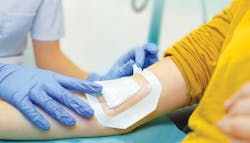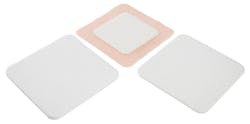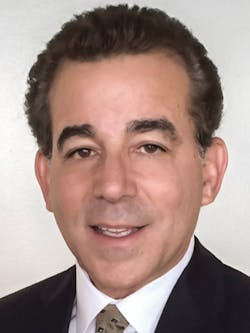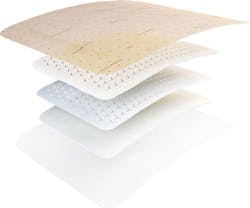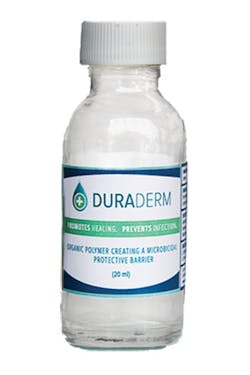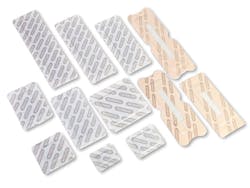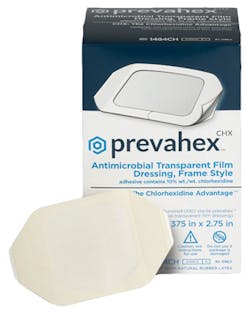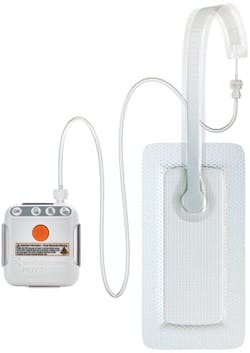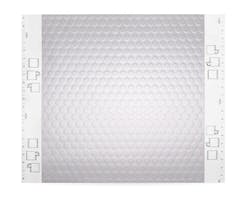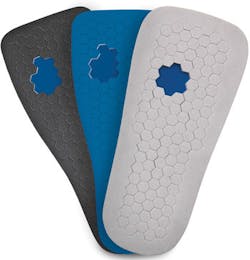Money is always a concern in healthcare, but quality healthcare is even more important. The trick is to balance cost against care. If you spend a little more for a more effective, more productive application that reaps better outcomes, results can be easier on the patient while boosting the health of the hospital’s pocketbook. Advanced wound-care supplies are one example. They may cost more, but they may not have to be replaced as often, which means a caregiver’s time with the wound is reduced; they may thwart infection, which can mean less follow-up procedures; and they may cut down on length of hospital stay.
The right product for the right patient
Ott explained the importance of looking at the total cost of care when selecting products. “In wound care, sometimes the treatment at the lowest initial price point isn’t as effective or needs to be used more often. More cost, time, and effort goes into healing the wound if all quality factors aren’t considered. Focusing on the right product for the right patient will ultimately reduce overall costs and improve patient outcomes. For example, we’ve had several instances of member hospitals moving to less-expensive preventative foam dressings or cohesive wraps as part of a cost-saving initiative and then reverting back to their original products due to patient quality outcomes.”
Ott stressed the value of teamwork in product selection. “We’ve seen that a way to mitigate this issue is to be sure clinical staff and the wound-care teams are involved in the product selection or value-analysis process before making any product conversions.”
Paul Saunders, Senior Global Marketing Manager, Advanced Wound Care, Vancive Medical Technologies, an Avery Dennison business, offered a rundown on types of wound-care products available to healthcare providers. “Wound-care products cover a huge spectrum of technologies, capabilities, materials, and prices. You have the very–high-technology, low-volume, high-priced items like negative-pressure pumps to low-technology, huge-volume, very–low-priced gauzes. With the advent of a range of antimicrobials, honey, silver, polyhexamethylene biguanide, and chlorhexidine gluconate (CHG), the healthcare provider has a wide range to choose from. The key is to find the balance that benefits the patient, reduces healthcare personnel time, and manages the budget in the optimal way.
Saunders concluded, “As they say ‘buy cheap, buy twice.’ The skill is finding the right dressing, at the right price, at the right time. If we can do this, patient outcomes will improve and total healthcare budgets will decrease or allow the greatest resource, staff, to be deployed in other value-add areas.”
Outsourcing wound management
Jeffrey Galitz, MD, DPM, FACFAS, DABPS, CEO, CMO, Woundtech, said they combine “best evidence-based care driven by technology in a high-touch, high-tech methodology.” He said that Woundtech heals 30 percent more wounds thirty percent faster than other wound-care providers. “By bringing the wound-care center to the patient and utilizing the best wound-care products, we are able to achieve these results.”
Galitz talked about costs. “Woundtech saves health plans approximately 70 percent in direct costs, lowers wound-related hospitalizations by 95 percent, and eliminates 95 percent of expensive, unproven modalities. Woundtech employs advanced practitioners including, nurse practitioners, physician assistants, podiatrists, and physicians.”
Dressings that minimize wound trauma
The fewer dressing changes a patient has to endure is good for the patient. It is also good for reducing costs. David Venner, Vice President, Sales and Marketing U.S., Wound Care, Mölnlycke Health Care explained their approach. “Mölnlycke Health Care’s focus on innovation and research has resulted in state-of-the-art dressings for both pressure-injury prevention and wound management. Among the most recent advances is Mepilex Border Flex, specifically designed to support fewer dressing changes, reducing dressing costs and waste, while creating an optimal healing environment. The unique Flex technology with Y-cuts was designed to stay on and conform even to difficult anatomy.”
Venner related Mölnlycke’s philosophy: “At the heart of everything we do at Mölnlycke is the understanding that the right dressing leads to better outcomes for patients — and a better bottom line for providers. Facilities that think they are achieving savings with a lower-cost dressing may actually be spending considerably more due to frequent dressing changes.”
Relating the experience of a case at a 250-bed Denver community hospital, Venner said, “Mepilex Border Flex dressings reduced dressing utilization by 78 percent, with a cost reduction of 74.2 percent, or an average of $68 per patient in dressing costs, when compared with their formulary dressing.1 Wear time was three days compared to less than one day with the other dressing.”1
Venner explained that standardizing on Mölnlycke dressings can offer substantial savings to facilities. He provided an example: “One of the largest rural non-government IDNs in the country reported increased healing rates, savings of 48 percent, and better-quality wound care by standardizing to Mölnlycke’s Advanced Wound Care products.”
Antimicrobial dressings
Jeff Elbl, Chief Technology Officer of Prevent-Plus, explained how DuraDerm works. “As it dries, its patented polymer creates an elastomeric film that seals over the wound, protecting against water, germs, and dirt. The lowered pH of the sealed wound creates an environment that promotes wound healing.” Elbl claims, “No other known cidal agent protects against superbugs while also protecting wounds from external contamination and promoting healing. DuraDerm’s triple action prevents infection and promotes healing, which greatly reduces the risk of additional interventions, saving time, money, and healthcare resources.
“DuraDerm has effectively been tested to kill, on contact, several superbugs, such as methicillin-resistant Staphylococcus aureus (MRSA) and vancomycin-resistant Enterococcus (VRE),” stated Elbl. “Most recently, an independent laboratory study showed that DuraDerm is one of the first products on the market that kills 99.99 percent of the Candida auris fungus on contact. C. auris presents a serious global health threat because the fungus is often multidrug-resistant, difficult to identify with standard lab tests, and has caused recent outbreaks in healthcare settings.”
Citing the cost of surgical-wound infections (SSIs), one of the most common types of HAIs, Elbl continued, “They occur an estimated 160,000 to 300,000 times per year and account for more than twenty percent of all HAIs. These infections can be a major source of readmissions and affect overall hospital performance. Overall, SSIs cost the U.S. healthcare system an estimated $3.5 to $10 billion annually. The finding that up to 60 percent of SSIs are preventable has made SSI a primary target of institutions’ quality-control measures and a key ‘Pay-for-Performance’ metric. Clinicians can spur hospital executives and administrators to look at investing in new interventions or technology by working collaboratively to provide a cost-benefit analysis.”
Cura Surgical’s antimicrobial of choice is silver, long recognized for its inherent antimicrobial properties. Raul Brizuela, Founder, President, and CEO of Cura Surgical, described the virtues of their dressing. “Silverlon Antimicrobial Dressing is an evidence-based product used across multiple specialties to help healthcare professionals protect patients from HAIs. Silverlon contains more metallic silver than any other dressing on the market and utilizes unique technology to deliver silver ions to the wound. Silverlon provides a broad-spectrum antimicrobial effect that rapidly kills microorganisms, eradicating pathogens such as MRSA and Pseudomonas in as little as four hours.”
Highlighting the necessity of scientific validation, Brizuela noted that multiple studies have been published across different surgical specialties on Silverlon Antimicrobial Dressing. “A study out of the University of South Florida2 assessed a total of 61,000 central-line days. The facility sought to improve infection rates and justify an organizational change to Silverlon and changed their bundle for central-line maintenance to include Silverlon as the standard of care. After a change in protocol, they realized a drop in infections from 1.64/1,000 central -line days to 0.87/1,000 central-line days. This number has stayed steady for six-plus years.”
Brizuela continued, “In addition to cost savings to the hospital, and the ripple effect of patient satisfaction on reimbursement, preventing HAIs can have an impact on per-patient reimbursement and overall Medicare reimbursement, if the hospital performs below average. The hospital stands to lose zero to two percent reduction in overall Medicare reimbursement if infection rates are below national average.”
“PrevahexCHX is a proven technology effective against the most dangerous pathogens in healthcare today including MRSA, VRE, and Candida albicans,” continued Holinga. “In a recent study conducted by an 800-bed urban hospital in the Northeast, the PrevahexCHX antimicrobial dressing was significantly more likely to last to therapy completion and contribute to lower overall complication rates, likely due to prolonged suppression of bacterial growth. In addition, it has been reported that one of the biggest advantages of the PrevahexCHX product was the chlorhexidine antimicrobial component, to decrease the skin flora in the incisional area, as the incision is commencing the healing process. Pre-clinical studies have demonstrated normal wound healing occurs with our technology and does not impair or slow down this process.”
Fish skin
Fish skin can be a valuable tool in wound care, and that is no fish story. Gudmundur Fertram Sigurjonsson, President and CEO, Kerecis, recounted how it works. “Kerecis Omega3 Wound is fish skin that has been shown to speed healing, reduce pain, lower infection, and reduce the cost of treatment. The Kerecis fish skin enables the body to regenerate tissues rather than simply repair them and risk scarring. Because no disease-transfer risk exists between cold-water fish and people, the Kerecis fish skin is only gently processed, preserving the human-skin-like structure. The product’s large, thick sheets are easy to use and reduce the need for multi-layer grafts.” A bonus is that “fish skin also contains Omega3 fatty acids, which have anti-inflammatory properties and enhance wound healing.”
Sigurjonsson related that Kerecis technology has been the subject of more than 50 clinical studies. “Two double-blinded, prospective, randomized clinical studies found that wounds treated with Kerecis Omega3 Wound healed significantly faster than wounds treated with mammalian skin substitutes. Quality wound-care products can typically speed healing, reducing the possibility of amputations, improving patients’ lives, and lowering costs because fewer treatments are needed.”
Of note, are the documented cost savings outlined in the studies. ”Studies show that the Kerecis product costs 76 percent less than the leading amniotic-membrane product, based on the average selling price of the two treatments and the number of treatments needed,” stated Sigurjonsson.
Negative-pressure wound therapy
Negative-pressure wound therapy applies sub-atmospheric pressure to the wound by means of a sealed wound dressing that is connected to a vacuum pump. Mie Zagger, SVP AWM, U.S. Marketing, Smith & Nephew, described their PICO Single Use Negative Pressure Wound Therapy System (sNPWT) as including “a pump and an innovative dressing, which has a proprietary AIRLOCK Technology Layer that uniformly and consistently delivers sufficient NPWT across a surgical incision and the surrounding zone of injury.3,4 This feature is designed to help reduce the risk of wound complications by removing post-operative fluid and associated lateral tension around a closed surgical incision.5,6 The combination of these actions may help reduce the risk of surgical-wound dehiscence3 and SSIs,7 the two most common SSI complications.”
Zagger referred to a scientific study in support of their product. “A meta-analysis of twenty-nine studies showed that PICO sNPWT helped reduce the risk of SSIs by 63 percent, the risk of seroma by 77 percent, and the risk of dehiscence by 30 percent.3 The studies also showed an almost two-day reduction in length of hospital stay, providing substantial cost savings and efficiency gains across the healthcare system.3
“The meta-analysis evaluated results from peer-reviewed publications, including ten randomized control trials and involving 5,614 patients, to assess the average effect of PICO sNPWT application across a wide variety of surgical indications, on SSIs, dehiscence, and length of hospital stay in comparison to standard of care.”
Zagger noted that the meta-analysis3 calculated “overall number of high-risk patients needed to treat (NNT) with PICO sNPWT to prevent one costly and potentially dangerous and painful SSI was just 14; this was further reduced to an NNT of five for patients undergoing colorectal surgery. This underlines the importance of adopting the use of this advanced and novel innovation to help treat our patients with confidence and lower the potential incidence for post-surgical complications.”
DERMATAC Drape is a new, single-use, proprietary silicone-acrylic hybrid drape used as an accessory to vacuum-assisted closure therapy. Ronald Silverman, MD, FACS, Chief Medical Officer, KCI, said, “NPWT dressing applications can be cumbersome, time-consuming for clinicians, and sometimes painful for patients. We sought to address these challenges by re-engineering drape design and chemistry, leading to the introduction of DERMATAC Drape, which adapts to body contours and is strong enough to maintain a seal for up to 72 hours, yet is gentle at removal. It has operational benefits for clinicians, such as the ability to reposition the drape during initial application and dressing changes without losing adhesion, and it is easier to use across multiple wound types.”
Silverman continued, “In a limited commercial release across twenty-one U.S. centers and approximately 350 patients in acute and post-acute facilities, DERMATAC Drape held a seal for 72 hours. A majority of the patients who received DERMATAC Drape agreed it was painless upon removal, and eighty-five percent of clinicians said DERMATAC Drape was easier to use and faster to apply than traditional drapes. Patients may remain on NPWT longer, or behave more compliantly with a skin-friendly drape, which may reduce long-term wound-care costs. Ancillary product use to achieve a seal may be reduced, saving total product costs. DERMATAC Drape demonstrated a 33 percent reduction in application time, which may result in net savings based on less operating-room time.”
Diabetic-wound shoes
Diabetic wounds can be difficult to heal. Life and limb can be threatened if not responding to treatment, and there are myriad solutions. Jim Jeffrey, Distributor Sales Manager, DARCO International, asserted, “The DARCO Peg Assist, with our wound-care shoes, provides effective and affordable options. The DARCO PegAssist Off-Loading insole is ideal for diabetic patients with diabetic ulcers or wounds. DARCO offers three styles; each one is for a specific DARCO product. The removable hex-shaped pegs located on the bottom insole provide targeted off-loading. The patient walks on the blue Poron side of the insole. Each insole comes with a stabilizer board that covers the remaining hex-shaped pegs, to prevent them from falling out.”
Jeffrey described the components of the PegAssist Off-Loading insole as having three layers, Poron (top), Plastizote (middle), and EVA (hex-shaped pegs). “The materials complement each other. They provide support and help to reduce plantar pressure. This is important for patients with diabetic peripheral neuropathy. There are numerous international studies supporting the use of these materials.8,9
Revised References
1. Tyson LP. Study first: driving the case for improving hospital wound care. SAWC 2019: San Antonio, TX. Poster.
2. Karlnoski R, Abboud EC, Thompson, P, et al. Reduction in central line-associated bloodstream infections correlated with the introduction of a novel silver-plated dressing for central venous catheters and maintained for 6 years. J Intensive Care Med. 2019 Jul;34(7):544-549.
3. Saunders C, Buzza K, Nherera L. A single use negative pressure system reduces surgical site complications compared with conventional dressings in closed surgical incisions: a systematic literature review and meta-analysis. European Wound Management Association Annual Meeting; Gothenburg, Sweden; June 5-7, 2019. Poster.
5. Strugala V, Martin R. Meta-analysis of comparative trials evaluating a prophylactic single-use negative pressure wound therapy system for the prevention of surgical site complications. Surg Infect (Larchmt). 2017 Oct;18(7):810-819.
6. Malmsjö M, Huddleston, E, Martin R. Biological effects of a disposable, canisterless negative pressure wound therapy system. ePlasty. 2014;14.
7. Karlakki SL, Hamad AK, Whittall C, et al. Incisional negative pressure wound therapy dressings (iNPWTd) in routine primary hip and knee arthroplasties: a randomised controlled trial. Bone Joint Res. 2016;5(8):328-337.
7. Payne C, Edwards D. Application of the single use negative pressure wound therapy device (PICO) on a heterogeneous group of surgical and traumatic wounds. ePlasty. 2014:152-166.
8. Lin T-L, Sheen H-M, Chung C-T, et al. The effect of removing plugs and adding arch support to foam based insoles on plantar pressures in people with diabetic peripheral neuropathy. J Foot Ankle Res. 2013 Jul 29;6(1):29.
9. Rogers K, Otter SJ, Birch I. The effect of PORON and Plastazote insoles on forefoot plantar pressures. British Journal of Podiatry. 2006 (Nov);9(4):111-114.
About the Author

Susan Cantrell
Susan Cantrell is Infection Prevention Editor for Healthcare Purchasing News.
